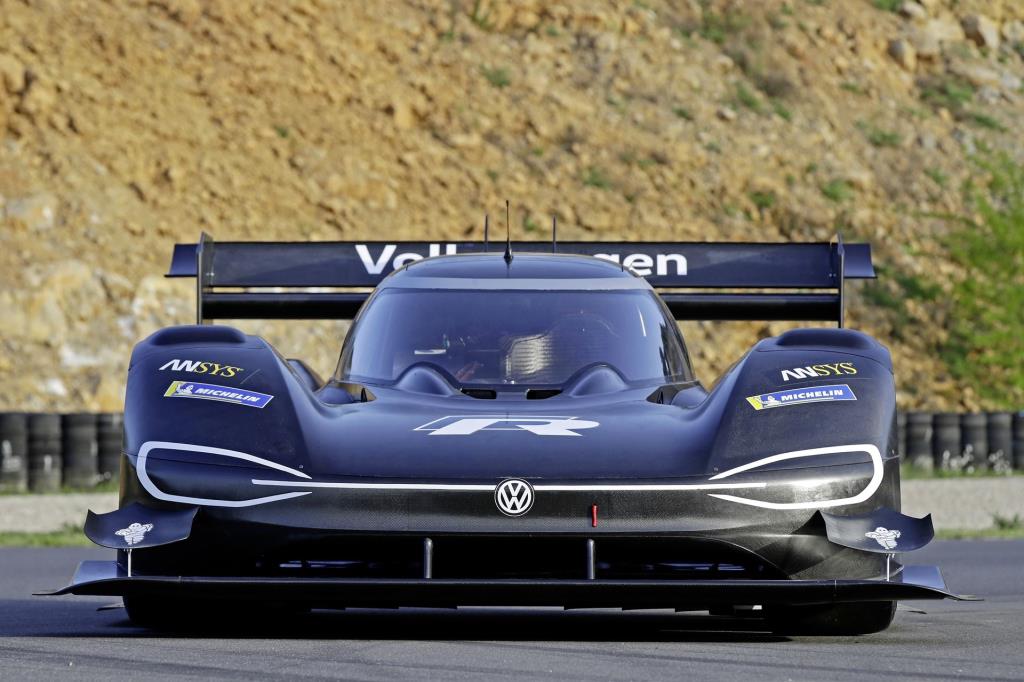Fully-electric race car weighs less than 2,425 pounds including the driver
'Before we actually assembled the I.D. R Pikes Peak, we used computers to analyse a multitude of different configurations,' said Willy Rampf, technical advisor to the project. 'It was clear to us that we would not have time to build multiple test vehicles. We had to get it right at the first attempt.'
The trials focussed on finding the optimal compromise between performance and weight. Both factors are more dependent on each other in an electric car than in a racing car with a conventional combustion engine. The simple rule of thumb is: The greater the performance, the heavier the batteries required. However, every single gram is unwanted weight—particularly at a hill climb.
On Pikes Peak, the cars must overcome a difference in altitude of more than 4,700 feet on the way to the finish line at 14,115 above sea level. Romain Dumas, at the wheel of the I.D. R Pikes Peak, will also be faced with a series of hairpin turns, where a heavy car would be a disadvantage when braking and accelerating out of corners.
Volkswagen Motorsport engineers decided on the following strategy: The I.D. R Pikes Peak was to be as light as possible, while still maintaining a very high level of performance. Fortunately, there are essentially no regulations for the 'Unlimited' class at Pikes Peak, giving the team complete design freedom.
'Simulation played a major role in achieving the low weight of the car,' said Rampf. For example, computers were used to design chassis parts in such a way that they are able to cope with the anticipated loads without any problems, and without appearing oversized—or overweight. The development team also nearly completely dispensed with the standard, but extremely expensive, materials commonly used in top-class motor racing, such as titanium. 'The chassis, suspension and safety structure of the I.D. R Pikes Peak are almost completely made of steel and aluminium,' said Demaison.
Despite this, the car, complete with driver, weighs less than 2,425 pounds—a lightweight compared to Pikes Peak category electric race-cars. A relatively low output of 500 kW (671 horsepower) allowed the batterycomponents for the I.D. R Pikes Peak to be so compact that they could be positioned next to and behind the driver, thus ensuring perfect weight distribution. They provide the energy for an electric motor on both the front and rear axles, while torque distribution is managed electronically.
The I.D. R Pikes Peak's chassis and aerodynamic components are made of an extremely light carbonfiber/Kevlar composite. One of the tasks faced during the design phase was to integrate design elements from the I.D. family—Volkswagen's future range of fully-electric vehicles—in the exterior of the Pikes Peak racing car. 'During this phase of development, we worked particularly closely with our Volkswagen colleagues in Wolfsburg,' said Willy Rampf.
The extent to which the engineers were willing to go to reduce weight is exemplified by the driver's equipment. Technology partner OMP made driver Dumas' fire-resistant race suit, as well as the seat padding and six-point harness, from particularly light material. Even the sponsors' logos are printed onto the overall, to save the weight of conventional patches.
However, Volkswagen Motorsport did have to give in on one point: The regulations of the Pikes Peak International Hill Climb stipulate that each driver must wear a large event emblem, roughly 15.7 square inches, on their race suit. The plan was to have this logo printed on Dumas' race suit too, but according to the regulations, it has to be sewn on. Demaison joked, 'The thread used for that weighs almost as much as the entire suit.'
Photo credit: Volkswagen
posted on conceptcarz.com
Wolfsburg (May 24, 2018) — In preparation for the Pikes Peak International Hill Climb 2018, the Volkswagen Motorsport team designed the I.D. R Pikes Peak to strike the best balance between performance and weight. The brand's first fully-electric racing car will take on the most famous hill climb in the world on June 24th in Colorado Springs, CO, aiming to break the record in the class for electric prototypes, which currently stands at 8:57.118 minutes.
Being given the proverbial blank sheet of paper and told to develop a new racing car from scratch is a dream for any engineer. 'To develop a car solely for this 12.4 mile hill climb is a very special task. There were virtually no bounds to the innovation shown by the engineers,' said François-Xavier Demaison, Technical Director at Volkswagen Motorsport.
posted on conceptcarz.com
Related Posts
Related Vehicles
Recent Posts
- Drive the Magic: Lexus Unveils a 'Wicked' Pair of Rides
- Mitsubishi Motors Acquires Its Own Shares From Nissan
- Models of the Marque – the 1960s: The Rolls-Royce Silver Shadow
- Mercedes-AMG Develops First Standalone High Performance SUV, 'Born in Affalterbach'
- Nissan achieves highest ranking among mass market car segment in J.D. Power 2024 U.S. Sales Satisfaction Index (SSI) Study


